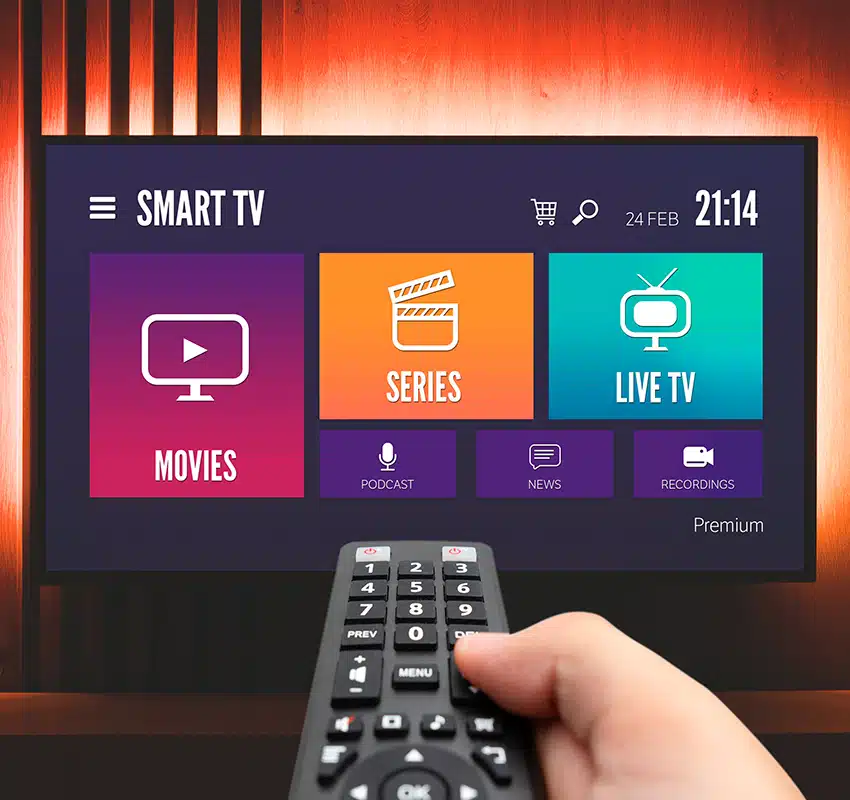What is Connected TV?
Connected TV (CTV) allows for connected TVs to connect to the internet and stream video. This includes smart TVs, set-top boxes, and TV sticks. In this article, discover what Connected TV is and how it’s changing advertising.
Key Takeaways
- Connected TV refers to television sets connected to the internet for streaming content, including smart TVs and various external devices.
- Connected TV advertising leverages the data-driven capabilities of digital advertising, allowing for precise targeting, high engagement rates, and detailed performance measurement.
- The future of Connected TV advertising is promising, with increasing recognition of its effectiveness and projected spending surpassing $100 billion by 2026 as more brands utilize data-driven strategies.
What is Connected TV ?
A Connected TV is a television set that has the capability to access and stream video content via an internet connection. This encompasses:
- Smart TVs equipped with built-in internet capabilities
- Supplementary devices such as set-top boxes
- Streaming dongles like the Amazon Fire Stick
- Video game consoles
- Various Connected TV gadgets that might still utilize a traditional cable cord
The central purpose of Connected TV is to enable viewers to merge services, providing them the ease of streaming from diverse platforms directly on their TV sets within the Connected TV ecosystem through specialized Connected TV applications.
Smart TVs lead in terms of connected television technology, boosting built-in streaming functions that eliminate the need for extra hardware. These smart TVs come loaded with applications from renowned streaming services, facilitating immediate content enjoyment at users’ fingertips. Nevertheless, smart TV or connected device ownership isn’t mandatory for entering into Connected TV. Streaming apparatuses like Roku and Amazon Fire TV Stick are prominent players as well, making up 60% of Connected TV market utilization, and they transform ordinary televisions into robust hubs capable of accessing countless streaming apps and offerings, including Apple TV.
It’s important to differentiate between Over-the-Top (OTT) content, which implies any online-delivered video material, and specific Connected TV viewing experiences on either smart TVs or similar linked equipment. For advertisers aiming at precision targeting within their advertising campaigns, this distinction becomes particularly crucial since it exploits web connections for presenting lively ads interactively right onto consumers’ screens.
How Does Connected TV Advertising Work?
Advertising on Connected TVs consists of presenting video advertisements via TVs linked to the internet while viewers consume streaming content. This method merges the targeted precision of digital advertising with the immersive visual appeal associated with traditional TV ads. Advertisers utilize programmatic platforms for executing and refining their connected TV ads, capitalizing on instantaneous data and analytical insights.
The distinct benefit of Connected TV Advertising lies in its capacity to serve ads alongside particular programs or films. By securing ads directly from providers of streaming services, advertisers can synchronize their messages with pertinent programming, enhancing user engagement. Such specificity contrasts sharply with linear TV advertising strategies that distribute commercials indiscriminately across broad audience demographics without specific targeting.
Utilization of data and sophisticated analytics is pivotal within Connected TV advertising campaigns. It empowers advertisers to monitor campaign performance as it unfolds, enabling prompt modifications to augment impact. The extensive targeting features permit ads to be shown to finely tuned demographic slices based on detailed criteria such as interests, viewing behaviors, and localities. Given the evolution towards an increased preference for streaming media consumption habits among audiences, today’s brands are compelled to tailor their promotional tactics accordingly through effective Connected TV advertising approaches.
Benefits of Connected TV Advertising
Connected TV advertising merges the widespread appeal and compelling visuals of traditional TV with the meticulousness and quantifiable nature of digital advertising. Numerous brands are coming to view Connected TV ads as potentially more effective than mobile ads in due course. This segment delves into the primary benefits provided by a Connected TV advertising platform, laying the groundwork for an in-depth examination of its specific strengths.
While traditional television ads can lead to excessive irrelevant views and suboptimal performance metrics, Connected TV ads cut down on such inefficiencies by employing precise targeting that bolsters viewer engagement and overall campaign impact. The heightened involvement typically observed among Connected TV audiences results in better video completion rates, which reinforces brand memory. These advertisements offer direct shopping capabilities within them, allowing viewers easy access to products without interrupting their entertainment.
One edge held by Connected TV is real-time tracking and measurement of how well an ad campaign performs. Advertisers have various attribution tools at their disposal to evaluate success while gaining insights into audience behavior and interaction levels with the ads, a feature greatly aiding in swift optimization efforts for maximum operational efficiency during ongoing campaigns.
Precise Targeting
Connected TV advertising is renowned for its ability to target with remarkable accuracy. Advertisers have the capacity to categorize their audience using a broad array of consumer traits, leveraging first-party data gathered from their own customer base as well as insights obtained from third-party sources. Such detailed targeting allows advertisers to focus on precise geographic areas through IP-based strategies, which in turn ensures that ads reach highly specific groups while reducing ineffective exposure.
Grasping the interests and behaviors of viewers is crucial when crafting tailored ad content within Connected TV advertising campaigns. This meticulous approach not only extends an ad’s reach across a vast audience, but also enhances its relevance to those it’s intended for. Thereby boosting both viewer engagement and the potential for conversions via strategic audience segmentation.
High Video Completion Rates
Watching ads on Connected TV provides an enhanced level of audience engagement and memory retention due to the captivating nature of large-screen viewing. Connected TV ads distinguish themselves from other digital advertisement types because they are often non-skippable and presented in full-screen mode, which leads to substantially higher rates of ad completion.
Connected TV advertising is recognized for its impressive video completion rates since numerous streaming services prohibit users from skipping ads. This guarantees that audiences watch the entire advertisement, boosting brand recognition and elevating the impact of campaigns featuring high-quality content.
Detailed Measurement and Attribution
Advertising on Connected TV offers the advantage of meticulously monitoring campaign effectiveness, allowing for immediate modifications to be made. Advertisers have access to critical indicators like return on advertising spend, generated revenue, and website traffic numbers that shed light on a campaign’s success.
The availability of real-time information, coupled with sophisticated attribution techniques, helps track consumer actions post-advertisement exposure. These insights gained from observing viewer behavior are crucial for accurate evaluation and credit allocation, thereby aiding advertisers in refining their campaigns to achieve enhanced outcomes.
Types of Connected TV Ad Formats
Connected TV advertising presents a diverse array of ad types crafted to captivate audiences. Options range from in-stream ads and interactive advertisements to conventional commercial-style spots. In-stream ads, which are concise video messages that cannot be clicked on, typically run before, during, or after streaming content with standard durations including 15 seconds, 30 seconds, and even brief six-second variants.
Interactive advertisements propel viewer engagement. By integrating features such as QR codes that connect to the viewer’s mobile device and external links for immediate interaction. These engaging formats not only hold the viewers’ attention but also prompt direct responses, facilitating a seamless transition from watching to making purchases.
Traditional commercials also find their place within connected TV advertising. They retain their classic approach while leveraging advanced digital targeting techniques along with refined measurement capabilities.
Key Metrics for Measuring Connected TV Campaign Performance
It’s imperative to assess the effectiveness of Connected TV campaigns in order to fine-tune advertising expenditure and attain targeted results. We’ll explore key Connected TV metrics that are instrumental for evaluating the success of Connected TV advertising, encompassing measures like impressions, reach, cost per completed view (CPCV), and return on advertising spend (ROAS).
Grasping these metrics empowers advertisers with the capability to monitor campaign performance as it unfolds and enact timely modifications that enhance outcomes. The precise quantification of pivotal performance indicators stands out as a major benefit of Connected TV advertising compared to traditional TV methods.
Impressions and Reach
The term impressions denotes the cumulative count of how often an advertisement is exhibited, offering clear insight into the delivery performance of an advertisement. Yet, determining the number of distinct households that have viewed ads grants a more precise assessment of reach compared to simply tallying individual impressions. Impressions and reach stand as critical indicators for gauging exposure to advertisements. With impressions documenting each instance, an ad appears and specifies the breadth of unique viewership.
Grasping both concepts, impressions and reach, is pivotal for advertisers aiming to refine Connected TV campaign efficacy in order to enhance engagement with their target demographic. Through close examination of these metrics, advertisers are equipped to confirm that their ads make an impact on intended consumers while also providing them with a foundation from which they can tailor future advertising endeavors for maximum effectiveness.
Cost Per Completed View (CPCV)
The CPCV (Cost Per Completed View) metric is essential for assessing the cost-effectiveness of Connected TV ads, as it indicates the expense incurred for each user-completed ad view. Advertisers rely on this measure to fine-tune their ad spend and enhance campaign outcomes.
Return on Ad Spend (ROAS)
The ROAS metric evaluates the financial effectiveness of Connected TV ad campaigns by comparing the revenue earned to the total amount spent on advertising, giving advertisers a clear picture of how much revenue is produced for every dollar invested in their ads. This allows them to determine the success and profitability of their ad campaigns accurately.
Best Practices for Connected TV Advertising
To optimize the impact of Connected TV advertising efforts, adhering to industry best practices is vital. Establishing clear objectives prior to initiating a campaign lays the groundwork for its achievement. The decisions related to selecting platforms, crafting ads, and pinpointing target audiences are shaped by the insights gained from preliminary inquiries.
Incorporating superior visual and audio elements is key for captivating an audience on expansive screens. Crafting emotionally resonant narratives within commercials tends to forge more profound bonds with viewers and bolsters ad recall rates. It’s important that a distinct call-to-action be simple yet emphatically echoed throughout the advertisement’s duration.
Leveraging real-time data from campaigns allows advertisers to distribute their budget with precision based on performance evaluations. Employing tools that monitor performance can shed light on pivotal metrics such as visitor counts, page view numbers, and how well different creatives are received by audiences. By committing to these proven strategies, advertisers can ensure maximum operational efficiency in their campaigns along with attaining their stipulated goals.
Future Trends in Connected TV Advertising
The outlook for Connected TV advertising remains strong, driven by the ongoing shift away from traditional cable and towards digital streaming platforms. As more households embrace on-demand viewing, advertisers are adjusting their strategies to align with evolving consumer behaviour. Connected TV is no longer seen solely as a branding tool, it’s now widely recognised as a performance-driven channel capable of delivering measurable outcomes. Marketers are increasingly prioritising high-quality inventory, acknowledging the value of premium environments for both brand impact and conversion.
Connected TV advertising enhances brand awareness and recall by combining the wide reach of traditional TV with digital precision. As more brands use data-driven advertising, the gap between supply and demand is expected to narrow, creating new revenue opportunities.
Summary
In summary, Connected TV advertising offers a powerful blend of traditional TV’s reach and digital advertising’s precision. The ability to target specific audiences, measure campaign performance in real-time, and achieve high engagement rates makes Connected TV an attractive option for advertisers. As viewing habits continue to shift towards streaming, brands that integrate Connected TV into their advertising strategies are well-positioned to succeed.
By understanding the benefits, ad formats, key metrics, and future trends in Connected TV advertising, marketers can optimize their campaigns for better results. The future of advertising lies in the ability to adapt to changing technologies and consumer behaviors, and Connected TV is at the forefront of this evolution.
Frequently Asked Questions
What is Connected TV (CTV)?
Connected TV encompasses any television connected to the internet that enables streaming of video content, such as smart TVs, set-top boxes, TV sticks, and gaming consoles.
How does Connected TV advertising work?
Connected TV advertising delivers video ads to internet-connected TVs during streamed content, using programmatic platforms for efficient ad delivery and placement.
This method allows for targeted advertising based on viewer data and preferences.
What are the benefits of Connected TV advertising?
Advertising on Connected TV enables advertisers to leverage the combined benefits of digital platforms and traditional TV by providing highly accurate targeting along with elevated video completion rates, which in turn facilitates effective measurement and attribution of campaign performance.
What types of ad formats are available in Connected TV advertising?
Connected TV advertising offers various ad formats, including in-stream ads, interactive ads, and traditional commercial-style placements, all aimed at effectively engaging viewers.
Each format is tailored to enhance the viewer’s experience and maximize advertising impact.
What are the key metrics for measuring Connected TV campaign performance?
The key metrics for measuring Connected TV campaign performance are impressions, reach, cost per completed view (CPCV), and return on advertising spend (ROAS), which together enable advertisers to effectively track and optimize their campaigns.
« Back to Programmatic Glossary Index
Let’s Get Started !
Let the Gourmet Ads team walk you through all the options available to ensure that your Food, Supermarket, Beverage or Kitchen advertising campaign has the best possible combination of Premium Guaranteed Inventory, Scale, First Party Data, Contextual Targeting and Programmatic Advertising elements.






